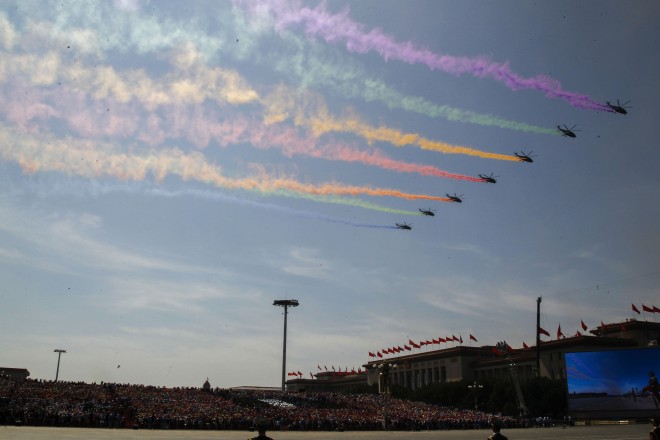China recognizes French priest for saving war refugees

Military aircraft fly in formation during a military parade to commemorate the 70th anniversary of the end of World War II, in Beijing on Sept. 3, 2015. AP
SHANGHAI, China — A long-dead French Jesuit priest has found himself with an unlikely role in China’s commemorations of the 70th anniversary of the end of World War II, as authorities highlight how he protected around 300,000 refugees.
Father Robert Jacquinot de Besange set up the Shanghai Safety Zone after Tokyo launched its full-scale invasion of China in 1937 and sent millions of refugees fleeing as the Japanese military and forces of China’s Kuomintang (KMT) party clashed.
Hundreds of thousands poured into the country’s commercial hub, and an estimated 250,000 to 360,000 found shelter in Jacquinot’s zone over the next three years.
“He saved the refugees,” said Professor Su Zhiliang of Shanghai Normal University. “During the fighting, when Shanghai set up the refugee zone, it was completely dependent on Jacquinot alone to create it.”
Su wants to put up a memorial to Jacquinot at the original location, preserve old buildings threatened by development in the former zone and even have the area declared a United Nations (UN) World Heritage Site.
Article continues after this advertisementAs a foreigner and a priest — two categories often considered sensitive by the Communist Party that has ruled the country since 1949 — China has largely ignored his achievements in recent decades.
Article continues after this advertisementBut the commemorations of the 70th anniversary of Japan’s defeat, which climaxed earlier this month with a huge military parade in Beijing, has also seen less combative elements, and Jacquinot has been the subject of a flurry of articles in state media and academic seminars. Last month, Shanghai authorities unveiled a statue of Jacquinot, now residing at a local museum.
“The interest in him is certainly greater,” said Marcia Ristaino, author of one of the few books about him, “The Jacquinot Safe Zone” published in 2008. “Back in those days, I didn’t find a lot of interest from the Chinese.”
Migrant crisis
Jacquinot, born in 1878 in the western French town of Saintes, arrived in Shanghai in 1913 to serve the church. A striking figure with a long black cassock and a white beard in later life, he lost his arm in a chemistry demonstration at the university where he taught.
His knowledge of languages — gained from living in England and instruction in both Chinese and the Shanghai dialect — served him well in the international city, helping him coordinate with officials, foreign diplomats and charitable groups to feed and house the refugees.
At the time, Shanghai was made up of the British-dominated International Settlement, the French Concession and a Chinese-governed area.
Jacquinot acted as an intermediary between the mayor, Yu Hongjun, and Japanese forces who occupied part of the metropolis, to broker an agreement setting up the zone in Nanshi district, the heart of the old Chinese city.
“Steamed buns and bread were handed out every day,” former refugee Li Fengxiang told state media. “There, we finally felt out of danger.”
Jacquinot’s efforts inspired other safety schemes in wartime China, and while the original zone closed in mid-1940, partly due to much lower refugee numbers, it would later earn a mention in the 1949 Geneva Convention and a 1977 protocol as an example of “neutralized zones” to protect civilian populations.
Author Ristaino believes Jacquinot still has relevance in the light of the migrant crisis now gripping Europe.
“This is a very positive story that might be even a little bit instructive as to how to set up a safe zone,” she said.
World Heritage
Nowadays, the annals of wartime history perhaps give a more prominent place to Shanghai’s role in sheltering tens of thousands of Jewish refugees escaping the Nazis in Europe from the 1930s.
Jacquinot himself died of illness in 1946, when he was heading the Vatican’s delegation in Berlin for the aid of refugees.
Su has suggested bundling Shanghai’s former Jewish ghetto, set up by the Japanese in 1943, with Jacquinot’s zone to apply to UN agency UNESCO for World Heritage status.
But obstacles stand in the way of the coveted title. Competition among Chinese localities to apply is fierce and the country already has nearly 50 World Heritage Sites, ranging from the Great Wall to the Terracotta Warriors.
Hongkou district, site of the former ghetto, wants to seek a different designation — UNESCO’s “Memory of the World” program, which seeks to preserve documentary heritage — for the collection of the Shanghai Jewish Refugees Museum.
Still, Su hopes the government in Beijing — which regularly excoriates Tokyo, accusing Japan of not learning the lessons of history — will back his efforts.
“This kind of application has an extremely important meaning,” he said.
During the whole of World War II, he insisted, Shanghai was “the city where the most refugees were saved”.